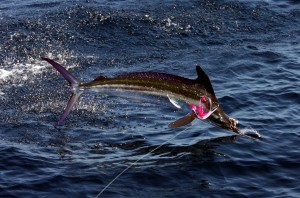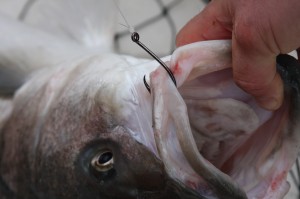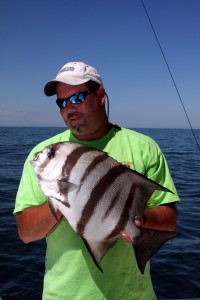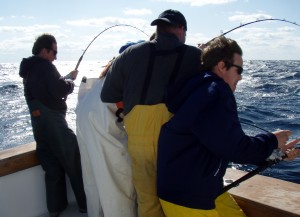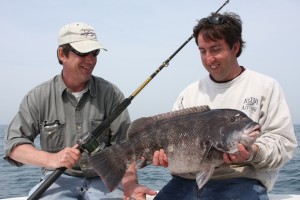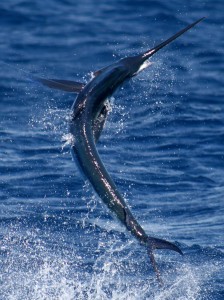Hot Shots
By Ken Neill
Originally published in The Fisherman Magazine
A good photograph can tell a story. Anglers love to tell stories. When recounting the details of a trophy catch, a photograph can be the difference in your audience’s minds between a tall tale and an accurate account of an amazing catch.
photograph can be the difference in your audience’s minds between a tall tale and an accurate account of an amazing catch.
Most fishermen will take a camera with them out on the water. The photographs which are brought back will vary anywhere from not being able to tell what the image is of to works of art which could grace the cover of a magazine. We are going to explore some tips which may help to make your photo album more interesting or maybe even to have editors asking to publish your works of art.
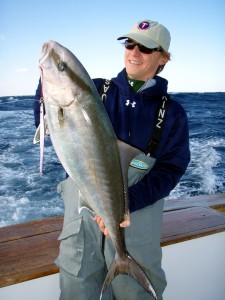 I am fortunate to be married to a very good photographer. Helpful criticism is as close as going home and when my photographs are not turning out the way I want, my wife, Tricia, can show me what to do differently. Ric Burnley is one of my regular fishing buddies. Ric also happens to be one of the most accomplished outdoor photographers/authors around. He is a good mentor. I have had the opportunity to fish and learn from a number of other outdoor photographers. Editors are also not bashful about letting you know what they want in a photograph. I still do not know what a f-stop is but I am learning how to make a better photograph thanks to these teachers.
I am fortunate to be married to a very good photographer. Helpful criticism is as close as going home and when my photographs are not turning out the way I want, my wife, Tricia, can show me what to do differently. Ric Burnley is one of my regular fishing buddies. Ric also happens to be one of the most accomplished outdoor photographers/authors around. He is a good mentor. I have had the opportunity to fish and learn from a number of other outdoor photographers. Editors are also not bashful about letting you know what they want in a photograph. I still do not know what a f-stop is but I am learning how to make a better photograph thanks to these teachers.
Everyone’s first question is what camera do you use? There is no right answer to this. It was not long ago that 35mm film was the “gold standard”. The quality of today’s digital cameras make them your best choice now. For a fishing camera, things like durability and water 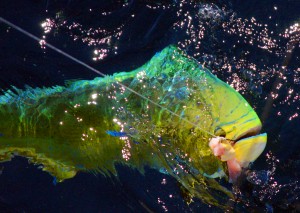 resistance should be considered. Most any quality digital point-and-shoot camera can take good photographs. Olympus has a Stylus series of cameras which are compact, waterproof, and very rugged. If you want the ability to change lenses or want to capture action shots of leaping fish, you will need to invest in a digital SLR camera. The professional photographers I have fished with have been pretty evenly divided between Canon and Nikon brand cameras.
resistance should be considered. Most any quality digital point-and-shoot camera can take good photographs. Olympus has a Stylus series of cameras which are compact, waterproof, and very rugged. If you want the ability to change lenses or want to capture action shots of leaping fish, you will need to invest in a digital SLR camera. The professional photographers I have fished with have been pretty evenly divided between Canon and Nikon brand cameras.
Whichever camera you use, there are some little things you can do to help your fishing photographs tell a better story. These are some tips I have been taught and I am just passing them along to you.
Take a lot of photographs
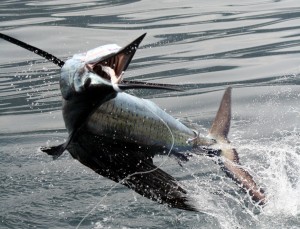 The saying used to be, “Film is cheap”. With today’s cameras, memory is even cheaper. Take a lot of photographs. The more you take the better your chance of getting that hot shot. I am not just referring to taking photographs of a lot of different things but taking multiple photographs of the same thing. With the display screen on your camera, you can check the image you just made but you really will not know the quality of your shot until you see it on a big screen. Take several so you have a better chance of having a really good one. Now, if you are taking a photograph of a fish which will be released, you need to do this quickly. For a fish destined for the fish box, take a little time and get some good shots.
The saying used to be, “Film is cheap”. With today’s cameras, memory is even cheaper. Take a lot of photographs. The more you take the better your chance of getting that hot shot. I am not just referring to taking photographs of a lot of different things but taking multiple photographs of the same thing. With the display screen on your camera, you can check the image you just made but you really will not know the quality of your shot until you see it on a big screen. Take several so you have a better chance of having a really good one. Now, if you are taking a photograph of a fish which will be released, you need to do this quickly. For a fish destined for the fish box, take a little time and get some good shots.
Shoot large
Set your camera to take photographs at the highest possible resolution. While lower resolution photographs may be  fine for posting on the Internet and looking at on your computer, the highest resolution make the best prints. When you do get that great shot, high resolution will allow you to have a large print made for your wall or it may allow your photo to be used as the next cover of your favorite fishing magazine. If you get serious about selling your photographs, consider shooting in RAW format if your camera has that ability.
fine for posting on the Internet and looking at on your computer, the highest resolution make the best prints. When you do get that great shot, high resolution will allow you to have a large print made for your wall or it may allow your photo to be used as the next cover of your favorite fishing magazine. If you get serious about selling your photographs, consider shooting in RAW format if your camera has that ability.
It is the fish!
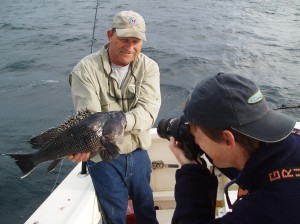 The focus of a fish photograph is the fish. It should be what draws your eye first. The person holding the fish is secondary.
The focus of a fish photograph is the fish. It should be what draws your eye first. The person holding the fish is secondary.
The eyes have it
Look at the eyes. If the focus of a fish photograph is the fish. The focus of the fish is the eye. The eye of the fish should be in sharp focus for a good photograph.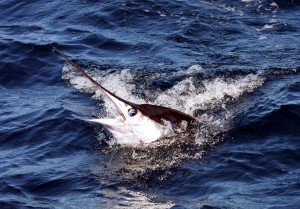
Take it now
Fish photographs are best when the fish is bright and full of color. A dull dead fish does not make a good subject. Take your photographs as soon as you safely can. For some larger, toothy fish, you may need 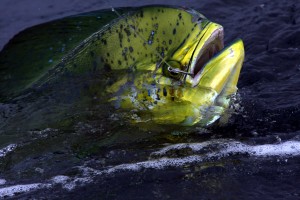 to wait a bit but take your photographs as soon as possible. Photographs of a bunch of dead fish back at the dock can tell a story too but the best photographs are made when the action is happening.
to wait a bit but take your photographs as soon as possible. Photographs of a bunch of dead fish back at the dock can tell a story too but the best photographs are made when the action is happening.
Fill the frame
Move in close. Fill in the frame with your intended subject. Close photos have more of an impact than ones with a lot of space around your subject.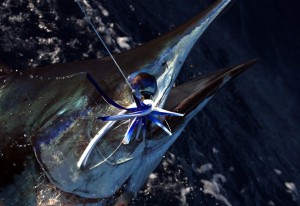
Watch your background
What is behind your subject can detract from a photograph. On a boat, this can be a challenge. Fishing rods are sticking out of rod holders all over the boat. A rod directly behind an angler will look like it is growing out of his head. The horizon needs to be considered. Where the sky and water meet creates a distinct 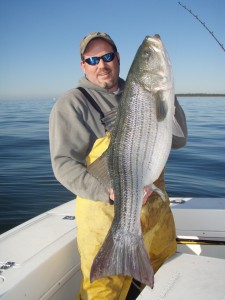 line in a photograph. This line can draw the eye if it looks like it is passing through the angler’s head. Another common problem with the horizon, is that while we know that it should be horizontal, a rocking boat can often have the horizon appear at extreme angles in a photograph. Try to keep the horizon horizontal.
line in a photograph. This line can draw the eye if it looks like it is passing through the angler’s head. Another common problem with the horizon, is that while we know that it should be horizontal, a rocking boat can often have the horizon appear at extreme angles in a photograph. Try to keep the horizon horizontal.
Avoid distractions
Your background can be a source of distractions. Other distractions could be a cigarette or a beer can. Blood is a distraction. Take photos of clean fish. What is a distraction depends on what story you are trying to tell. A photograph for your fishing album can tell one story. A photograph destined to be published in a magazine, may need to tell a different story. Editors do not like distractions.
Smile!
Fishing is fun! Anglers should look happy. A smile can help to animate any photograph. It also is a benefit if your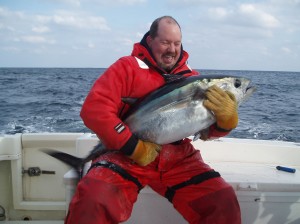 angler is wearing bright, colorful clothing.
angler is wearing bright, colorful clothing.
The dark side
Shadows are a problem. Be aware of where the sun is. Avoid dark faces due to hats, maybe take the hat off. Shadows darkening any 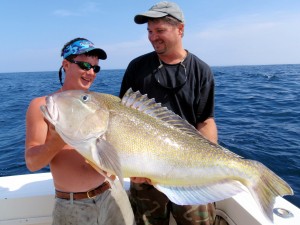 part of your photo will take away from the photo but you really do not want them across your fish. Turn the boat. Move things which are casting the shadows. Use your camera’s fill flash to help get rid of dark areas.
part of your photo will take away from the photo but you really do not want them across your fish. Turn the boat. Move things which are casting the shadows. Use your camera’s fill flash to help get rid of dark areas.
The hero shot
The angler proudly holds his fish up and looks at the camera. The photographer holds his camera horizontal and takes the photograph. The basic fishing photo every editor says that he does not like but you will find in every fishing magazine and in every fishing photo album. Go ahead and take these shots. They do tell a story but also mix it up and take some other shots.
Turn your camera vertical and shoot some that way for some different looks. Vertical shots also work best for magazine covers. Have two people in the photo, looking at each other. If there is just the one angler, have him 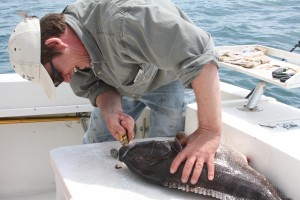 interacting with the fish. Have him looking at the fish, removing the hook. Include the tackle used to catch the fish. Have the fish held at different angles. Take photographs from different angles. Take close ups of just the fish. Action shots of fish being fought, landed and released can be great. Take photos of the fish in the water. Photos of jumping fish are always a challenge to get but are well worth the effort when you “get the shot”.
interacting with the fish. Have him looking at the fish, removing the hook. Include the tackle used to catch the fish. Have the fish held at different angles. Take photographs from different angles. Take close ups of just the fish. Action shots of fish being fought, landed and released can be great. Take photos of the fish in the water. Photos of jumping fish are always a challenge to get but are well worth the effort when you “get the shot”.
Use your imagination and try different things but be careful. This can be addictive. When that next big fish hits, instead of trying to beat your fishing buddy to the rod, you just may find yourself rushing to get your camera.